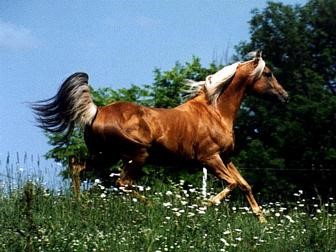Morab horses were originally developed in the late 1880’s
through the cross-breeding of Arabian and Morgan horses. They were developed
with the intent of creating a fine carriage horse that was still substantial
enough for moderate farm labor. The modern Morab continues this tradition of
paired power and elegance, being both attractive and competitive show animals,
and strong but mild-mannered work and family horses.
The first Morab registry was created in 1973. Prior to this,
Morabs were primarily undocumented horses bred for type. Many early Morabs were
registered with the American Morgan Horse Association, as the Morgan studbook
was still open that time, and these horses have since been fully assimilated
into the Morgan breed.
Newspaper tycoon William Randolph Hearst was an avid Morab
breeder, and is credited with the creation of the breed name by coining the
term, Morab, as a combination of the names of the parent breeds – MORgans +
AraBian.
Their typical conformation is compact, with powerful but
sleek muscle structure and substantial bone structure, while remaining refined
and elegant. Their neck is deep-set, strong, and arched, providing for easy
breathing and fluid mobility. Morabs, like some other horse breeds of heavy
Arabian ancestry, have a compact build and shorter back length, with a
well-developed undercarriage and good propulsion from behind.
Their hindquarters are generally powerfully built,
possessing substantial muscle and bone. Their forequarters are typically built
very strongly as well, with a large, sloping shoulder and wide deep chest. Legs
are rather thick, due to Morgan-influenced bone structure. They have
comparatively short cannon bones, and solid, well-developed hooves.
Their head is generally very refined, carrying the Arabian's
concave profile and wide forehead to some degree, while also displaying a more
strongly muscled jaw and more substantial muzzle, typical of Morgan influence.
Their eyes are large, bright, and expressive, and afford the horse a very wide
field of vision. Their ears are generally small and alert, and are often fluted
or tipped. Many Morabs have a thick and abundant mane and tail, often wavy and
flowing, and "flagged" tail carriage, indicative of both Morgan and
Arabian parentage.
The size range of Morabs is quite broad, due to the
involvement of extensive lineages from both Arabian and Morgan breeds.
Generally, Morabs stand between 14.2 and 15.2 hands (58 to 62 inches, 147 to
157 cm) high, but individuals can range from 14.0 and 16.0 hands (56 to 64
inches, 142 to 163 cm) or larger.
Their temperament and personality is best described as a
true combination of the Morgan and the Arabian. Morabs are generally very
intelligent, curious, and personal horses. They are often very quick to learn,
and establish strong relationships with humans, who they are eager to please.
Morabs make excellent family horses, and are sometimes used as lesson and
therapy horses.
All solid colors exist within the Morab breed, with bay,
chestnut, and gray being the most common. Dilution-factor coloration, such as
buckskin and palomino, also occurs frequently, owing largely to Morgan
influence, as dilution-factor genes do not occur in the Arabian breed. Tobiano,
overo, and Appaloosa colorations are not acceptable, as neither parent breed
displays such patterns. Roaning is occasionally seen, as is the dun pattern,
although both are rare in the Morab. White markings on the face and legs are
acceptable, and are somewhat common. The sabino spotting pattern does occur in
some Morabs, due to the presence of sabino coloration in select Arabian
bloodlines used in foundation Morab breeding.
Morabs are typically not gaited. However, due to inherited
genetic variation from select Morgan bloodlines capable of producing gait, a
few individual Morabs are able to perform ambling, or intermediate, gaits. The
most common intermediate gait in such morabs is the singlefoot, also known as
the 'stepping pace.' Other known gaits are the foxtrot and the true rack.

